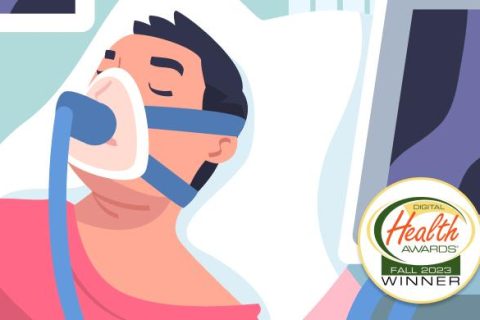
CPAP vs. BiPAP
BiPAP and CPAP devices differ primarily in their air pressure delivery. BiPAPs provide distinct air pressure levels for inhalation and exhalation, whereas CPAPs maintain a constant fixed pressure throughout each breath. Both BiPAPs and CPAPs can enhance sleep quality and overall well-being.
Understanding CPAP and BiPAP Systems
Continuous positive airway pressure and bilevel positive airway pressure machines are both breathing aids used to treat obstructive sleep apnea. Typically diagnosed after a sleep study, sleep apnea is a condition that occurs when your airway is obstructed or when your throat temporarily closes or becomes blocked while you’re lying down.
CPAP devices use one setting to keep the sleeper’s air passage open. BiPAP devices, however, use two settings — one for inhaling and one for exhaling. Both systems have the same essential parts and can be can customized to deliver optimal sleep support.
Both CPAP and BiPAP machines are similar to automatic positive airway pressure machines. CPAP and APAP machines differ in that while CPAP machines have one setting for continuous airflow, an APAP device automatically adjusts its setting to adapt to your breathing as you sleep.
What Is CPAP and How Does It Work?
A CPAP system consists of a motor, a cushioned mask, a tube, headgear and adjustable straps to ensure a perfect fit. The small tabletop machine’s compressor pushes a pre-calibrated stream of purified air through tubing to the mask.
The fit of the mask is important because it ensures the correct amount of pressurized air goes to the throat to keep the airway open. Escaped air can result in too little pressure, rendering the machine less effective.
Doctors are prescribing an increasing number of CPAP machines to adults as more research shows the negative short- and long-term effects of poor sleep on overall health. They also request them for people with severe breathing difficulties and for infants born with poorly developed lungs.
CPAP Recalls, Injuries and Reported Deaths
Some CPAP systems have proven problematic, including Philips CPAP, BiPAP and ventilator machines, which were recalled in July 2021. The U.S. Food and Drug Administration classified the recall as Class 1 because of CPAP cancer risks and the potential for other serious injuries or death.
According to a 2022 study evaluating 2,571 patient injuries associated with CPAP between 2014 and 2021, 4.62% of patients reported cancer development after use, the second most commonly documented issue. In September 2022, Philips recalled about 1,660 BiPAP ventilators globally because contaminated plastic that could be present in the device motor.
Recalled Philips devices have the potential to release toxic gases into the machine and device owners have filed CPAP lawsuits against the company. Between April 2021 and December 2022, the FDA received more than 98,000 medical device reports of side effects and there were 346 reported deaths.
Benefits of CPAP
Multiple sleep studies show CPAP therapy to be an effective way for people with sleep apnea not only to get the sleep they need, but to stave off sleep-related heart failure, strokes and death.
Sleep apnea symptoms include loud snoring, occasional gasps for air and inconsistent breathing. It can lower the amount of oxygen a person receives and raise the amount of their carbon dioxide intake.
- Minimize and sometimes eliminate snoring
- Keep oxygen levels optimized while sleeping
- Provide more energy through better quality of sleep
- Protect heart health
- Lower the risk of diabetes
- Help with weight loss
- Improve mood through better sleep
While there are no guarantees that all patients will experience these benefits, using a CPAP device under the guidance of a medical professional can significantly alleviate sleep apnea symptoms. Some users can experience side effects of CPAP such as nasal dryness, skin irritation or respiratory infections.
What Is BiPAP and How Does It Work?
Like CPAP machines, BiPAP machines also carry many benefits to people who use them correctly. Unlike CPAPs, BiPAPs use a higher pressure for the inhalation phase and a lower pressure for the exhalation phase. Dual pressures facilitate more natural breathing and reduce the human pressure needed to exhale.
Most BiPAP machines offer three air-pressure settings. Doctors adjust them based on the individual’s needs.
- Spontaneous switching automatically senses breathing patterns. This allows the system to adjust the inspiratory positive airway pressure (IPAP) and exhalation positive airway pressure (EPAP) levels.
- Timed switching allows the patient to program the duration of both the IPAP and EPAP phases. This setting is good for people who want to maintain the ideal breath rate — the optimal number of breaths per minute.
- Spontaneous/timed switching is a primarily spontaneous setting, designed to support natural breathing patterns and detect drops in this pattern. When the machine senses a drop below a preset number of breaths per minute, the system automatically adjusts to correct for the deficiency.
BiPAP systems are appropriate for a broad range of people, including those with congestive heart failure, coronary artery disease, hypertension and other pulmonary and neurologic disorders.
Benefits of BiPAP
BiPAP machines are a common alternative to CPAP and offer similar benefits for people who live with sleep apnea. Properly prescribed and used correctly, they significantly lower the amount of snoring and sleep interruptions, laying the foundation for quality, rapid eye movement (REM) sleep.
Because of their multiple settings, BiPAP machines offer more options than CPAPs for people who have breathing restrictions. They improve gas exchange, which enhances respiratory function and allows the body to sleep more efficiently.
This makes them ideal for individuals whose sleep studies show have elevated carbon dioxide levels. BiPAPs can deliver optimal performance for people with central sleep apnea because of their adjustability.
Because of the independent IPAP and EPAP pressures, BiPAPs make exhalation easier and more relaxed than CPAPs. Computerized optional breath features allow for the setup of ideal breath rates. When engaged, the system autocorrects air pressure settings when the sleeper does not achieve preset breathing rates.
Is BiPAP Better for Sleep Apnea than CPAP?
BiPAP and CPAP systems both have high rates of effectiveness for treating sleep disorders. The continuous pressure of CPAP machines works especially well for people who have obstructive sleep apnea, while BiPAP machines are better suited for treating central sleep apnea, complex sleep apnea or chronic obstructive pulmonary disease (COPD). It’s easier to exhale with a BiPAP than with a CPAP.
Because of their increased complexity, BiPAP machines cost more than CPAP machines. Most health insurance plans, including Medicare and Medicaid, include coverage for sleep disorders and the machines needed to treat them. The amount of coverage depends on your specific insurance plan.
However, those who seek help with their sleep issues do not always have a choice between the two systems. Sleep specialists pick them and must write a detailed prescription in order for someone to receive a sleep machine. Doctors sometimes explain the strengths and benefits of both systems, including costs, and let patients choose.
Calling this number connects you with a Drugwatch.com representative. We will direct you to one of our trusted legal partners for a free case review.
Drugwatch.com's trusted legal partners support the organization's mission to keep people safe from dangerous drugs and medical devices. For more information, visit our partners page.


